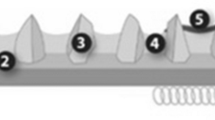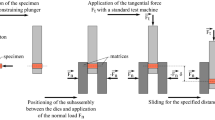Abstract
An enhancement of an existing tribometer device developed by Philippon et al. (Wear 257:777–784, 2004) is presented in this work. This experimental device is made up of a dynamometer ring and a specific load sensor allowing to apply an apparent normal force on specimens and to measure frictional forces respectively. A set of strain gauges are added to the upgraded dynamometer ring in this new configuration. The apparent normal force can be recorded accurately during the sliding process. The setup is adapted on a hydraulic testing machine to carry out steel-on-steel dry sliding tests. The first set of standard Steel on standard Steel specimens (XC 38 French standard steel) with two apparent normal pressures are imposed (8 and 80 MPa) as the range of sliding velocities varies from 0.12 to 3.72 m/s for the same contact conditions. The main set of experiments with low sliding velocities (varying from 0 to 3 m/s) for the Steel 1080 on Steel VascoMax are performed in the same tested setup. The recordings of normal and tangential forces leading to the friction coefficient determination are discussed. The values of dry friction coefficient μ according to the experimental parameters are in good agreement with those observed in the literature. Using this new configuration, the effects of the sliding velocity on the surface roughness changes and on the dry fiction coefficient are also investigated. Additionally the surface roughness changes are also investigated. Performing the scans with use of the scanning electron microscope in particular locations of the specimens show the roughness decrease and reveal the occurrence of the wear phenomenon. Moreover, very interesting relations between wear and sliding velocity are observed.



















Similar content being viewed by others
References
Philippon S, Sutter G, Molinari A (2004) An experimental study of friction at high sliding velocities. Wear 257:777–784
Sutter G, Philippon S, Molinari A (2004) An experimental investigation of dry friction for a large range of sliding velocities. In: Matériaux et techniques “Crashworthiness”, pp 33–36
Mariac L (1980) Introduction à l’étude du frottement. Editions Carima
Philippon S, Sutter G, Dedourge A, Molinari A (2003) Etude experimentale du frottement. Int J Mech Prod Syst Eng High Speed Mach 57–60. ISSN 1291–8199
Rajagopalan S, Prakash V (1999) A modified torsional kolesky bar for investigating dynamic friction. Exp Mech 39(4):295–303
Espinosa H, Patanella A, Fischer M (2000) A novel dynamic friction experiment using a modified kolsky bar apparatus. Exp Mech 40:138–153
Espinosa H, Patanella A, Fischer M (2000) Dynamic friction measurements at sliding velocities representative of high-speed machining processes. J Tribol 122:834–848
Prakash V (1995) A pressure-shear plate impact experiment for investigating transient friction. Exp Mech 35(4):329–336
Clifton J, Klopp R (1985) Pressure-shear plate impact testing. Metals handbook 8, mechanical testing, pp 230–239
Bowden FP, Freitag E (1958) The friction of solids at very high speeds. I. Metal on metal; II. Metal on diamond. Proc R Soc Lond, A Math Phys Sci 248:350–367
Couetard Y (2000) Caractérisation et étalonnage des dynamométres à six composantes pour torseur associé à un système de forces. PhD thesis, Université de Bordeaux, Bordeaux, France
Kim J, Kim D (1997) Development of a combined-type tool dynamometer with a piezo-film accelerometer for an ultra-precision lathe. J Mater Process Technol 71:360–366
Korkut I (2003) A dynamometer design and its construction for milling operation. Mater Des 24:631–637
Yaldiz S, Unsacar F (2006) Design, development and testing of a turning dynamometer for cutting force measurement. Mater Des 27:839–846
Yaldiz S, Unsacar F (2006) A dynamometer design for measurement the cutting forces on turning. Measurement 39:80–89
Yaldiz S, Unsacar F, Saglam H (2006) Design, development and testing of a four-component milling dynamometer for the measurement of cutting force and torque. Mech Syst Signal Process 21:1499–1511
Sutter G, Philippon S, Garcin F (2006) Dynamic analysis of the interaction between an abradable material and a titanium alloy. Wear 261:686–692
Zineb MB, Philippon S, Chevrier P, Lipinski P (2008) Détermination expérimentale de l’effort d’interaction aux grandes vitesses: application aux matériaux abradables. Rev Méc Appl Théorique 1(10):749–757
Tounsi N, Otho A (2000) Dynamic cutting force measuring. Int J Mach Tools Manuf 40:1157–1170
Tounsi N, Otho A (2000) Identification of machine-tool-workpiece system dynamics. Int J Mach Tools Manuf 40:1367–1384
Castro L, Viéville P, Lipinski P (2006) Correction of dynamic effects on force measurements made with piezoelectric dynamometers. Int J Mach Tools Manuf 46:1707–1715
Faure L, Philippon S, Lodygowski A, Voyiadjis G, Rusinek A, Chevrier P, Dossou E (2009) Design of a dynamometer capable of capturing the dry friction force in dynamic conditions. In: Rusinek A (ed) International workshop in memory of J.J.R. Klepaczko. Metz, France
Faure L, Philippon S, Lodygowski A, Voyiadjis GZ, Rusinek A, Chevrier P, Dossou E (2009) Evolution of an original device allowing the determination of the dry fricion coefficient in dynamic conditions. In: Theoretical and experimental approaches for the dynamic industrial processes. Carlos III University in Madrid, Madrid, p 31
Lim SC, Ashby MF, Brunton JH (1989) The effects of sliding conditions on the dry friction of metals. Acta Mech 37(3):767–772
Lim SC, Ashby MF (1987) Wear- mechanism maps. Acta Metall 35(1):1–24
Yun S, Palazotto AN (2007) Damage mechanics incorporating two back stress kinematic hardening constitutive models. Eng Fract Mech 74:2844–2863
Oden JT, Martins J (eds) Models and computational methods for dynamic friction phenomena. (Stuttgart, Germany), Fenomech III
Bowden FP, Persson PA (1960) Deformation heating and metling of solids in high speed friction. Proc R Soc Lond A 260:433–458
Bowden FP, Hughes TP (1939) The friction of clean metals and the influence of absorbed gasses. The temperature coefficient of friction. Proc R Soc Lond A172:263–279
Archard JF (1953) Contact and rubbing of flat surfaces. Int J Phys 24:981–988
Drucker DC (1954) Coulomb friction, plasticity, and limit loads. J Appl Mech 21:71–74
ASM (1997) Friction and wear testing. ASTM. ISBN 0871706172
Abed FH, Voyiadjis GZ (2005) A consistent modified zerilli-armstrong flow stress model for bcc and fcc metals for elevated temperatures. Acta Mech 175:1–18
Voyiadjis GZ, Abu Al-Rub RK (2006) A finite strain plastic-damage model for high velocity impact using combined viscosity and gradient localization limiters: Part II. Numerical aspects and simulations. Int J Damage Mech 15:335–373
Acknowledgements
The authors would like to acknowledge the technical department of National Engineering School of Metz, especially Mr. Patrick Schmitt, for his contribution in the machining of main parts of the new apparatus. Authors would also like to thank to Région Lorraine for providing the financial support to develop this first project stage. The second and fourth authors gratefully acknowledge Dr Anthony N. Palazotto of the Air Force Institute of Technology at WPAFB, Ohio for providing them with steel 1080 and steel VascoMax specimens as well as the many discussions they had on this research. The second author also acknowledges support provided for the research by World Class University (WCU) program through the National Research Foundation of Korea funded by the Ministry of Education, Science and Technology (R32-2008-000-20042-0).
Author information
Authors and Affiliations
Corresponding author
Rights and permissions
About this article
Cite this article
Philippon, S., Voyiadjis, G.Z., Faure, L. et al. A Device Enhancement for the Dry Sliding Friction Coefficient Measurement Between Steel 1080 and VascoMax with Respect to Surface Roughness Changes. Exp Mech 51, 337–358 (2011). https://doi.org/10.1007/s11340-010-9368-9
Received:
Accepted:
Published:
Issue Date:
DOI: https://doi.org/10.1007/s11340-010-9368-9




